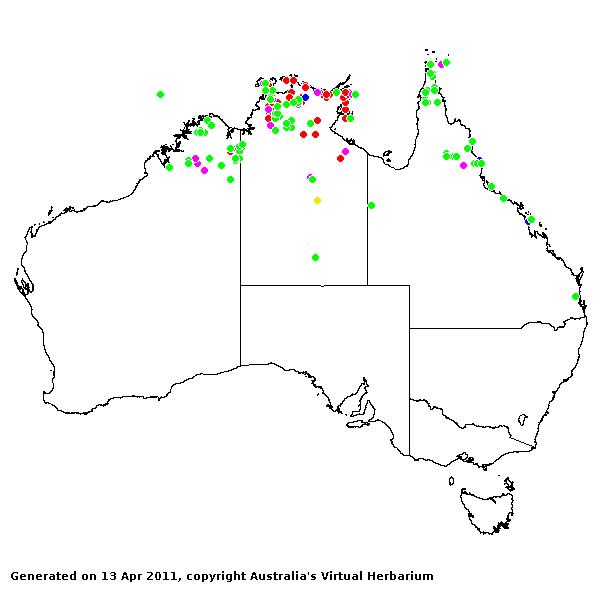Cenchrus pedicellatus* (Trin.) Morrone, Ann. Bot. 106: 128 (2010).
Classification. (GPWG 2001) : Subfamily Panicoideae. Paniceae.
Basionym and/or Replacement Name: Pennisetum pedicellatum Trin., Mem. Acad. Petersb. Ser. 6: 3,1. 184 (1835).
Type of Basionym or Protologue Information: HT: D. Peters s.n., Cape Verde Islands, St. Iago (LE-TRIN-1101.01).
Key references (books and floras): [2002] D.Sharp & B.K.Simon, AusGrass, Grasses of Australia as Pennisetum pedicellatum.
Habit. Annual or perennial. Rhizomes absent. Stolons absent. Culms geniculately ascending, 30–150 cm tall. Lateral branches branched. Ligule a fringed membrane, a ciliate membrane. Leaf-blades 5–25 cm long, 4–15 mm wide.
Inflorescence. Inflorescence solid, a panicle. Panicle linear, 5–15 cm long.
Spikelets. Spikelets sessile and pedicelled, 1–5 in the cluster. Involucre composed of bristles. Fertile spikelets 2-flowered, the lower floret barren (rarely male), the upper fertile, comprising 1 basal sterile florets, comprising 1 fertile floret(s), without rachilla extension, lanceolate, dorsally compressed, 3.5–6 mm long.
Glumes. Glumes dissimilar, thinner than fertile lemma. Lower glume lanceolate or oblong, hyaline, without keels, 0–1 -nerved. Lower glume surface indumented. Upper glume ovate, membranous, without keels, 5–7 -nerved. Upper glume surface indumented. Upper glume apex muticous or mucronate. Florets. Basal sterile florets 1, male or barren, with palea or without significant palea. Lemma of lower sterile floret 100 % of length of spikelet, membranous, 5 -nerved.
Fertile lemma 2.5–3 mm long, without keel, 5 -nerved. Lodicules absent or vestigial. Anthers 3. Grain 0.5–2 mm long.
Continental Distribution: Africa, Temperate Asia, Tropical Asia, Australasia, and South America.
Australian Distribution: Western Australia, Northern Territory, Queensland.
Western Australia: Gardner. Northern Territory: Darwin & Gulf. Queensland: Burke, Cook, North Kennedy, South Kennedy, Wide Bay.
Infra-specific taxa: subsp. pedicellatus, subsp. unispiculus .
Involucre with 1 spikelet C. pedicellatus subsp. unispiculus
Involucre with 2–5 spikelets C. pedicellatus subsp. pedicellatus






